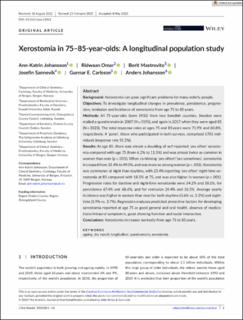| dc.description.abstract | Background: Xerostomia can pose significant problems for many elderly people.
Objectives: To investigate longitudinal changes in prevalence, persistence, progression, remission and incidence of xerostomia from age 75 to 85 years.
Methods: All 75-year-olds (born 1932) from two Swedish counties, Sweden were mailed a questionnaire in 2007 (N = 5195), and again in 2017 when they were aged 85 (N = 3323). The total response rates at ages 75 and 85 years were 71.9% and 60.8%, respectively. A ‘panel’, those who participated in both surveys, comprised 1701 individuals (response rate 51.2%).
Results: At age 85, there was almost a doubling of self-reported ‘yes often’ xerostomia compared with age 75 (from 6.2% to 11.3%) and was almost twice as common in women than men (p < .001). When combining ‘yes often’/‘yes sometimes’, xerostomia increased from 33.4% to 49.0%, and was more so among women (p < .001). Xerostomia was commoner at night than daytime, with 23.4% reporting ‘yes often’ night-time xerostomia at 85 compared with 18.5% at 75, and was also higher in women (p < .001). Progression rates for daytime and night-time xerostomia were 34.2% and 38.1%, for persistence 67.4% and 68.6%, and for remission 24.4% and 16.5%. Average yearly incidence was higher in women than men for both daytime (3.6% vs. 3.2%) and night-time (3.9% vs. 3.7%). Regression analyses predicted protective factors for developing xerostomia reported at age 75 as good general and oral health, absence of medications/intraoral symptom/s, good chewing function and social interaction.
Conclusions: Xerostomia increases markedly from age 75 to 85 years. | en_US |

